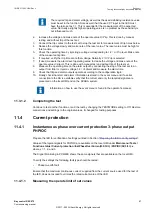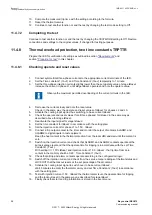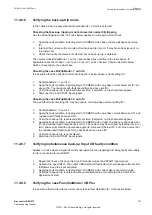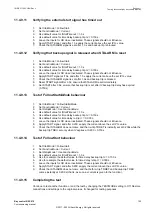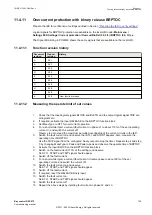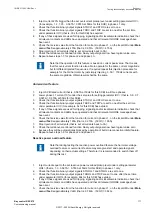
Residual overvoltage release and protection
SEMOD175060-131 v6
Procedure
1.
Measure that the operate voltage is equal to the
UN>
setting.
The function activates the START and STUN signals.
2.
Measure the operate time by injecting a voltage 1.2 times set
UN>
operate value.
3.
Compare the result with the set
tUN
operate value.
4.
Inject a voltage 0.8 ·
UNRel>
and a current high enough to operate the directional function at
the chosen angle.
5.
Increase the voltage until the directional function is released.
6.
Compare the measured value with the set
UNRel>
operate value.
11.4.6.2
Completing the test
SEMOD175060-148 v4
Continue to test another function or end the test by changing the
TESTMODE
setting to
Off
. Restore
connections and settings to the original values, if changed for testing purposes.
11.4.7
Thermal overload protection, one time constant, Celsius/
Fahrenheit LCPTTR/LFPTTR
M14950-2 v7
Prepare the IED for verification of settings as outlined in section
Check that the input logical signal BLOCK is logical zero and that on the local HMI, the logical signal
TRIP, START and ALARM are equal to logical zero.
11.4.7.1
Measuring the operate and time limit of set values
M14950-8 v3
Testing the protection without external temperature compensation (NonComp)
M14950-10 v10
1.
Quickly set the measured current (fault current) in one phase to about 300% of
IRef
(to
minimise the trip time), and switch the current off.
2.
Reset the thermal memory on the local HMI under
Main menu /Reset /Reset temperature /
ThermalOverload1TimeConst(PTTR,26) /LFPTTR:x
,
Main menu /Reset /Reset
temperature /ThermalOverload1TimeConst(PTTR,26) /LCPTTR:x
,
3.
Switch the fault current on and take note of the temperature, available on the local HMI under
Main menu /Test /Function status /Current protection /
ThermOverLoad1TimeConst(PTTR,26) /LFPTTR:x /TEMP
,
Main menu /Test /Function
status /Current protection /ThermOverLoad1TimeConst(PTTR,26) /LCPTTR:x /TEMP
,
4.
Check the time until the actual temperature TEMP has reached the
AlarmTemp
level during
injection.
Monitor the signal ALARM until it appears on the corresponding binary output or on the local
HMI.
5.
Measure the LCPTTR/LFPTTRprotection trip time.
Use the TRIP signal from the configured binary output to stop the timer.
6.
Take the TEMP readings.
Compare with the setting of
TripTemp
.
7.
Activate the BLOCK binary input.
The signals ALARM, START and TRIP should disappear.
8.
Reset the BLOCK binary input.
9.
Check the reset limit (TdReset).
Monitor the signal START until it disappears on the corresponding binary output or on the local
HMI, take the TEMP readings and compare with the setting of
ReclTemp
.
1MRK 511 403-UEN Rev. L
Section 11
Testing functionality by secondary injection
Bay control REC670
97
Commissioning manual
© 2017 - 2022 Hitachi Energy. All rights reserved
Summary of Contents for REC670
Page 1: ...Relion 670 SERIES Bay control REC670 Version 2 2 IEC Commissioning manual ...
Page 2: ......
Page 28: ...22 ...
Page 54: ...48 ...
Page 60: ...54 ...
Page 66: ...60 ...
Page 90: ...84 ...
Page 212: ...206 ...
Page 218: ...212 ...
Page 232: ...226 ...
Page 240: ...234 ...
Page 241: ...235 ...





